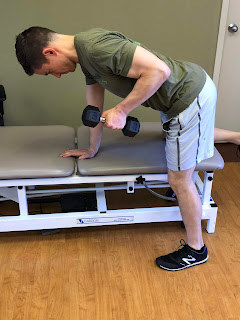It is 7:14 pm on Thursday,
November 8, and I have summited my Everest! I just completed my 50th
book of 2018 and it has been a grueling and amazing journey! Rebecca can attest
to the countless hours of audiobooks that have provided a cacophony of 1.5 x
speed sounds in our home for the past year. Thank you Rebecca for staying with
me in my sickness, as you promised in your vows.
I have spent the last weeks
reflecting on the books I have read this year and a couple of things come to mind
about my journey:
1. 50
books is a ton of freaking books! Especially for the kid that was bearish on
reading after high school English class and the endless dissection (to a fault,
in my humble opinion) of literature.
2. My
mom is probably smiling as she reads this, and takes credit for the early
nourishment of my reading habit through summer book reports.
3. Tracing
the words with your index finger while you read is like reading at 1.5 x speed.
I would still be plodding along through these books if I didn’t stumble upon
this little trick.
4. Choosing
a favorite book is like choosing a favorite pair of socks, I love them each for
their unique attributes (not children – I find it hard to believe I could like
or love another child as much as this little nugget)
Have you ever noticed that the
world seems more stressed these days? We all have a to-do list a mile long and
5 minutes to complete it. We wear our stress as a badge of honor, bragging to
anyone who will listen how busy we are and how little time we have available to
us. Chronic stress is all around us, and it sucks the energy right out of us. We
see it in the clinic every day, manifesting in multiple body system impairments
and increasing levels of musculoskeletal pain. You know who isn’t overly
stressed or busy…Amelie! She wakes up each day with a smile that says, “Good
morning world! What do you have in store for me today?” She wears that smile
until the moment she goes to sleep, and it truly is infectious.
How can I bottle up that smile
and take it with me as an espresso-shot of happy? This conundrum led me to my
next book…
What exactly is the impact that
stress has on the body? To find out, I decided to read Why Zebras Don’t Get
Ulcers by Robert Sapolsky and it was an eye opening experience! Sapolsky is
a neuroendocrinologist (super smart dude who studies the effects of hormones on
the nervous system) who writes about the effects of chronic stress on everything in the body. He took
me on a roller coaster ride as he beat me down for 17 chapters on how chronic
stress is sucking the life out of each of the major systems in my body. He
finished the book by restoring my hope for humanity with some actionable steps
for how to combat stress and minimize its detrimental effects on the body. He
discussed 2 processes for stress adaptation:
1. Homeostasis
– body tinkering on a structural level (tactics) to maintain the status quo
2. Allostasis
– brain coordinating body-wide changes, often including changes in behavior
(principles)
Naturally, we want to focus on
allostatic responses – global responses that have the most bang for their buck!
When in doubt, principles over tactics.
10,000 FOOT VIEW:
Acute stress response is a good thing and keeps us alive! The acute
stress response is a physiological reaction that
occurs in response to
a perceived harmful event, attack, or threat to survival. Sounds pretty good,
right? Lion chases after you in the Serengeti – mobilize stress response to
kick the lion’s ass or run like the wind!
Chronic stress is a very bad thing and it is sucking the life out of
us! You cannot fight/flee the lion
all day/every day. What happens to the body when we are in a constant stress
response? During chronic stress:
1. LDL
cholesterol (bad) levels are elevated and HDL (good) levels are diminished
2. Elevated
insulin levels in blood and insulin resistance in the body (diabetes)
3. Elevated
systolic and diastolic blood pressure (heart
disease)
4. Elevated
glucocorticoid levels (stress hormone) block the uptake of dietary calcium and
accelerate the resorption of bone (osteoporosis)
5. Chronic
stress suppresses immune function (sick)
6. Elevated
stress and glucocorticoids inhibits
neurogenesis (growth and development of
nervous system)
7. Less
time spent in deep sleep (portion of
sleep critical for restoration of new memories, consolidates information from
previous day)
To sum up - Chronic stress is
maladaptive and impacts everything in
the body. How many of your patients present with 1 or more of the comorbidities mentioned above when they get referred to your clinic with low back
pain?
We can fight the effects of
stress by treating the symptoms (ie taking a pill to treat your stress-related
illness). This homeostatic response is a good first step, but it is the
equivalent of putting a Band-Aid on a cut after you fall. If you avoid the fall
in the first place, you eliminate the need for the Band-Aid. Chronic stress is
the proverbial fall that is scuffing our knees.
LOW HANGING FRUIT:
How do we combat stress? Follow
this allostatic process!
1. Outlet for frustration – What is your
go-to outlet? As a physical therapist, I strongly encourage people to use
exercise as an outlet for frustration. The benefits of exercise are countless!
It is beneficial for cardiovascular purposes (see my blog post on The One
Minute Workout in Running Away From Running). It is even beneficial for
mental and brain health purposes – check out the book, Spark by John
Ratey to learn how he uses exercise as a treatment modality in his work as a
psychiatrist. There are so many other great resources on the benefits of
exercise - just ask me in the comments section!
2. Social support – we get this in PT,
working with a trainer, and group exercise classes (to name a few). Don’t take
your patients out of their group exercise classes! Let them continue to go to
their CrossFit box – shout out to CrossFit Adaptation – because the stress
outlet may be just as beneficial as the physical benefits from the WOD. Work
with your patient to modify their group exercise classes, but avoid benching
them, if at all possible.
3. Predictability – makes stressors less
stressful – talk to your patients about the stressors in their lives. How do
the daily Beltway commute and checking work email during dinner add stress to
your patient’s day? Talk to your patients about the microstresses that
accumulate into a stress cloud that follows your patients everywhere.
4. Control – This is where stress relief
tactics can be a game changer! If you have a specific activity that you can
employ to reduce your stress, now you have a sense of control. How can we address these stresses in the moment, in a
predictable fashion to gain a sense of control? In addition to exercise (as
mentioned above), Sapolsky talks about the benefits of meditation, and how it
reduces glucocorticoid levels and sympathetic tone (stress markers) while you
are meditating. I have been working to make meditation a morning habit for the
past 3 years and can personally attest to the effectiveness of the following
apps in my journey:
https://www.headspace.com/ This is a great app that provides guided meditation that is tailored towards
different stressors in your life – stuck in traffic? There is a guided
meditation for that. Nervous about a plane flight? Got that too. They even have
meditation packs for things like anxiety, depression, undergoing treatments for
cancer, and many others. To top it off, the guide Andy Puddicombe, is from the
United Kingdom and has that sweet UK accent! This is a subscription based app
(totally worth it) and it has a sample pack of 10 free guided meditations and
video tutorials to improve your meditation experience.
https://www.oakmeditation.com/ This is a great app (and it’s free!) that gets to the
heart of meditation – no frills, just 2 choices for guided meditation, 1 for
unguided, and some breathing drills.
Disclaimer – I have no ties to either of these apps
other than being a satisfied user of both.
5. Perception
of things improving – It can be a challenge to see how chronic stress is
improving on a short term basis. Our patients that have chronic pain go through
the same struggles. Help your patients objectively track their stress relief
tactics that will lead to long term changes in chronic stress (and pain for
that matter). It helps if their tactics are goal oriented and the goals should
be important to the patient. Whether they are exercising, meditating, or
performing some other stress relief tactic, it is helpful to keep a log of the
activity. Each week, there should be measurable changes towards the goal.
Here is a sample activity log
taken from my interval training to complete my 10 mile trail race earlier this
year (if you want to learn more, go check out my blog post Running Away From
Running J):
Long Term Goal: Finish 10 mile trail race using high intensity interval
training
Short Term Goal: Maintain speed of 29 mph on bike for 4 sets of 30
seconds
Activity: 4 x 30 second sprints on Airdyne (rest 2.5 minutes
between sets)
Set 1 – 28.5 mph
Set 2 – 29 mph
Set 3 – 29 mph
Set 4 – 28 mph
Rating of perceived exertion – 8,9,9,10.
Set 1 – did not warm up
adequately (early morning workout session and only spent about 2 minutes
warming up on the bike)
Set 4 – I was spent – I could
have used another 30 seconds of rest
The log can be as general, or specific,
as you like. The key is that you are working towards a short term and a long
term goal that you can objectively track.
WHAT DID I LEARN?
To combat chronic stress, be more
like your children (before they were sent to high school English class)!








